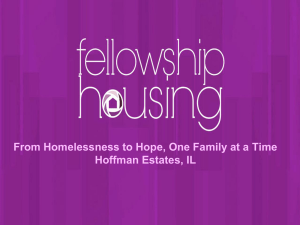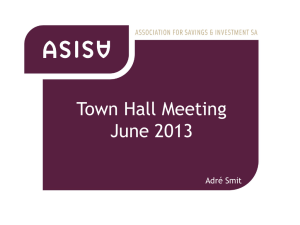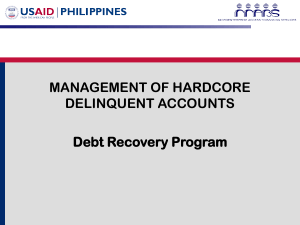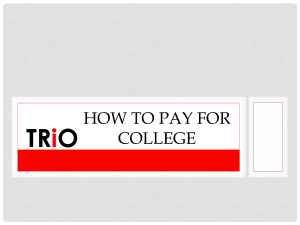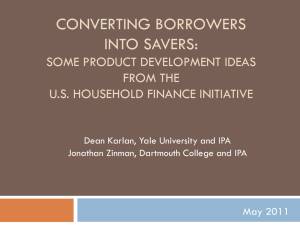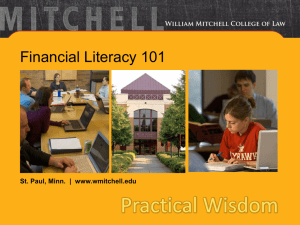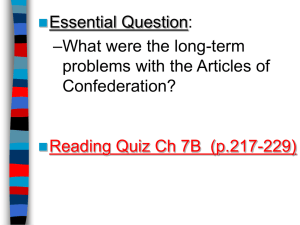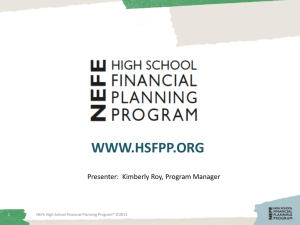Unit 4 - Good Debt, Bad Debt: Using Credit Wisely
advertisement
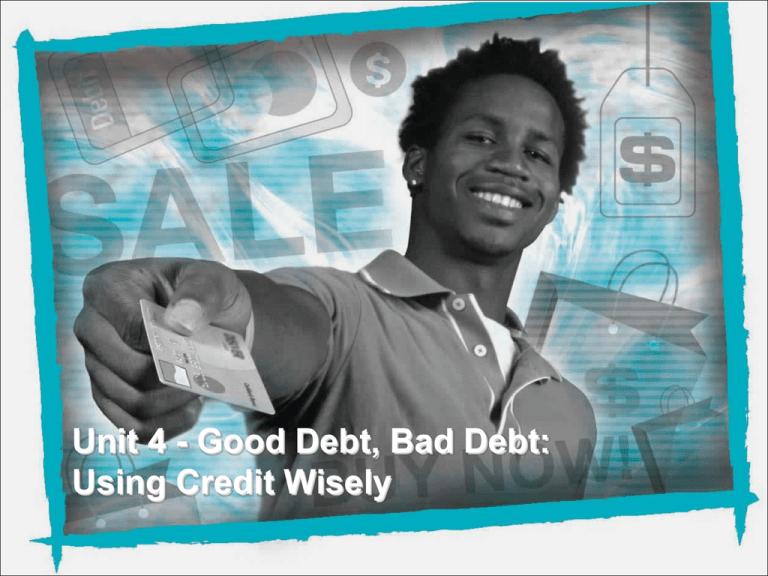
NEFE High School Financial Planning Program Unit 4 – Good Debt, Bad Debt: Using Credit Wisely Unit 4 - Good Debt, Bad Debt: Using Credit Wisely NEFE High School Financial Planning Program Unit 4 – Good Debt, Bad Debt: Using Credit Wisely Credit Facts • Nearly 33% of teens owe money to either a person or company, with an average debt of $230. • About 26% of teens ages 16-18 already have more than $1,000 in debt. • 30% of teens say they understand how credit card interest and fees work. • 36% of teens say they know how to establish good credit. 4-A NEFE High School Financial Planning Program Unit 4 – Good Debt, Bad Debt: Using Credit Wisely 10 Questions to Ask • • • • • • • • • • 4-B-2 4-B-3 4-B-1 Do I really need this item right now, or can I wait? Can I qualify for credit? What is the interest rate (APR) on this card? Are there additional fees? How much is the monthly payment, and when is it due? Can I afford to pay the monthly payments? What will happen if I don’t make the payments on time? What will be the extra cost of using credit? What will I have to give up to pay for it? All things considered, is using credit worth it for this purchase? 1 2 NEFE High School Financial Planning Program Unit 4 – Good Debt, Bad Debt: Using Credit Wisely The Language of Credit • Credit - is the amount of money or something of value that is loaned on trust with the expectation it will be repaid later to lenders. • Types of Credit – Borrow up to a predetermined limit (i.e., credit card) – Borrow cash to be repaid by a specific date – Borrow money for a major purchase to be repaid in regular payments over time, typically monthly (i.e., car loan, home mortgage) 4-C-1 1 of 4 NEFE High School Financial Planning Program Unit 4 – Good Debt, Bad Debt: Using Credit Wisely The Language of Credit • Debt is the entire amount of money you owe to lenders. • APR (Annual Percentage Rate) is the total cost to use credit in a year. • Term is how long you have to repay a loan, often expressed in months. • Fees are charged to use credit. Examples: Annual Credit Card Fee, Loan Origination Fee, Over-the-Limit Fee 4-C-2 2 of 4 NEFE High School Financial Planning Program Unit 4 – Good Debt, Bad Debt: Using Credit Wisely The Language of Credit • Credit History is a record of your behavior related to borrowing and repaying loans. • Credit Report is a detailed record of your personal credit and financial transactions. • Credit Score is a rating used by credit reporting companies to help lenders decide whether and/or how much credit can be extended to a borrower. 4-C-3 3 of 4 NEFE High School Financial Planning Program Unit 4 – Good Debt, Bad Debt: Using Credit Wisely The Language of Credit • Universal Default allows a credit card company to increase your interest rate if you make just one late payment. • Bankruptcy is a legal process to get out of debt when you can no longer make all your required payments. 4-C-4 4 of 4 NEFE High School Financial Planning Program Unit 4 – Good Debt, Bad Debt: Using Credit Wisely Types of Credit Installment Credit • Fixed payments • Set period of time to repay • Set or varying interest rates • Car loans and home loans are typical examples. 4-D Revolving Credit • No stated payoff time • Limit to credit • Minimum monthly payments • Interest rates vary or not • Finance charges • Credit cards most typical example NEFE High School Financial Planning Program Unit 4 – Good Debt, Bad Debt: Using Credit Wisely Sources of Credit • • • • • • • 4-E Banks Credit Unions Department Stores Automobile Dealers Oil Companies (for gas stations) Federal Government (for student loans) Others? NEFE High School Financial Planning Program Unit 4 – Good Debt, Bad Debt: Using Credit Wisely Basics of Credit • • • • • Pay off balance monthly to avoid interest Always pay on time (builds strong credit) Shop around for low interest rates Know grace periodnumber of days with no interest Pay more than the minimum payment NEFE High School Financial Planning Program Unit 4 – Good Debt, Bad Debt: Using Credit Wisely Credit Benefits • Access cash in emergency • Ability to use it now • Safety & Convenience • Bonus Points or Reward Points NEFE High School Financial Planning Program Unit 4 – Good Debt, Bad Debt: Using Credit Wisely College Students & Credit Cards o o o College students average credit limit is $5000 1/5 undergrads carry 4 or more cards Average revolving balance for college student $2500 NEFE High School Financial Planning Program Unit 4 – Good Debt, Bad Debt: Using Credit Wisely A little bit of credit card math You buy $500 worth of “STUFF” with your credit card. Your APR is 18%. You plan to pay $10 a month to pay it off. You will pay $431 in interest Final cost of your purchases = $931.40 And it will take SEVEN YEARS and NINE MONTHS 4-F 1 NEFE High School Financial Planning Program Unit 4 – Good Debt, Bad Debt: Using Credit Wisely How long it takes You owe $3,000. APR = 18% Payment: 4% of current balance Finance Charge $1715.69 Total cost of original $3,000 loan = $4715.69 4-G 1 And it will take nearly 11 YEARS to pay off! NEFE High School Financial Planning Program Unit 4 – Good Debt, Bad Debt: Using Credit Wisely The Cost of Using Credit $700 for a Game System APR = 24% Payment: 4% of current balance Finance Charge $550.04 Your CD player REALLY cost $1,250.04 4-H 1 And it will take over 7 years to pay off! NEFE High School Financial Planning Program Unit 4 – Good Debt, Bad Debt: Using Credit Wisely The Cost of Using Credit Interest Rate = 24% Payment = 4% of Current Balance 4-I BALANCE TIME TO PAY OFF INTEREST CHARGED TOTAL COST $2,000 11 YEARS 6 MONTHS $1,850 $3,850 $6,000 16 YEARS 1 MONTH $5,850 $11,850 $10,000 18 YEARS 2 MONTHS $9,850 $19,850 1 2 3 NEFE High School Financial Planning Program Unit 4 – Good Debt, Bad Debt: Using Credit Wisely $3,000 Charged to Credit Account APR = 21% Payment: 4% of current balance Finance Charges $2,220.57 Annual Credit Card Fee: $65 Paying the minimum, it will take you 11 YEARS and 11 MONTHS to pay off your debt. 4-J 1 You Owed $3,000 but You Paid $6,065+ Includies annual fees NEFE High School Financial Planning Program Unit 4 – Good Debt, Bad Debt: Using Credit Wisely 1 of 2 Financial Consequences of Debt • Could put you in a state of overspending and perpetual debt, where you get used to carrying a balance and paying extremely high interest rates. • Could adversely affect your credit rating, making it harder to get loans when you really need them. 4-K-1 1 of 2 NEFE High School Financial Planning Program Unit 4 – Good Debt, Bad Debt: Using Credit Wisely 2 of 2 Saving instead of spending • What if you took the $120 monthly payment in the last example and INVESTED $120 a month for the 12 years it took to pay off the $3,000 debt, and your investment got an 8% rate of return? • Instead of $6,000 paid out for $3,000 worth of “stuff”, your $120 monthly investments would amount to $28,799 in your pocket! 4-K-2 2 of 2 NEFE High School Financial Planning Program Unit 4 – Good Debt, Bad Debt: Using Credit Wisely How to get out of debt…. • Spend less than you earn! • Stick to budget • Pay all loans- even if it is minimum • Prioritize- highest interest rate first • Look for ways to cut costs NEFE High School Financial Planning Program Unit 4 – Good Debt, Bad Debt: Using Credit Wisely Bankruptcy Chapter 7- allows to erase debt, may require filer to be unemployed or low income. Must seek counseling; Also a liquidation type of bankruptcy that wipes out most debts in exchange for giving up most assets Chapter 13- allows pay back portion of debt with more time (3-5 years), court oversees repayment plan; allows people to keep their assets Lenders must absorb loan loss Responsible borrowers have to pay higher rates to recover Bankruptcy remains on credit report 10 years NEFE High School Financial Planning Program Unit 4 – Good Debt, Bad Debt: Using Credit Wisely Truth in Lending Act (1968) • • Also called Consumer Credit Protection Act Consumers can comparison shop for credit – 1. Lenders must disclose in writing total cost of using their credit – 2. Lenders must be truthful in their advertising about costs of their credit – 3. Gives rights to cancel credit within 3 business days – 4. Limits liability of credit card holder to $50 for unauthorized use NEFE High School Financial Planning Program Unit 4 – Good Debt, Bad Debt: Using Credit Wisely Fair Credit Reporting Act (FCRA) 1971 • Provides access to personal credit information on file with credit bureau • Credit bureau must investigate errors & correct report • Borrower’s have 30 days to review file without charge if denied credit NEFE High School Financial Planning Program Unit 4 – Good Debt, Bad Debt: Using Credit Wisely New CARD Act of 2009 • Creditors have to tell you: – How long it will take to pay off your balance. – When they plan to increase your rate or other fees. • • • • • No interest rate increases for the first year. Increased rates apply only to new charges. Restrictions on over-the-limit transactions. Caps on high-fee cards. Protections for underage consumers. • CARD Act Rules NEFE High School Financial Planning Program Unit 4 – Good Debt, Bad Debt: Using Credit Wisely The Four “Cs” of Credit Collateral Capital Capacity Character 4-L NEFE High School Financial Planning Program Unit 4 – Good Debt, Bad Debt: Using Credit Wisely How Credit Scores Are Determined •Your payment history –Information about how you make your payments on credit cards, store accounts, car loans, finance companies, mortgages –Accounts in collection or past due, and how long past due –Information in public records, such as bankruptcy, judgments, liens, wage attachments or child support 4-M-1 1 2 3 NEFE High School Financial Planning Program Unit 4 – Good Debt, Bad Debt: Using Credit Wisely How Credit Scores Are Determined •Your overall debt –How much you owe on all your accounts –How much credit you have available to use •Your credit account history –When you opened and used each of your accounts –How recently you applied for new credit –Recent good credit history following past payment problems 4-M-2 1 2 3 NEFE High School Financial Planning Program Unit 4 – Good Debt, Bad Debt: Using Credit Wisely How Credit Scores Are Determined •Types of Credit –The different types of credit accounts you have –The total number of accounts you have 4-M-3 1 2 3 NEFE High School Financial Planning Program Unit 4 – Good Debt, Bad Debt: Using Credit Wisely Get and Keep a Good Score • (FICO) Highest Score: 850 Average Score: 680 •Make sure your credit report is accurate. •Pay all your bills on time. •Apply for credit only when you need it. •Lower the balances on all your credit accounts. •Pay off debt rather than moving it around. 4-N NEFE High School Financial Planning Program Unit 4 – Good Debt, Bad Debt: Using Credit Wisely Protect Yourself: Inaccurate Credit Reports • Get a copy of your free credit reports from all credit rating agencies. • If you find something that is incorrect, ask the agency to investigate the information. • If that doesn’t resolve the issue, you can attach a short statement to your credit report. 4-O NEFE High School Financial Planning Program Unit 4 – Good Debt, Bad Debt: Using Credit Wisely Free Credit Report Annually • • • • Equifax Experian Trans Union Corporation Go to annualcreditreport.com • Against the law to obtain anyone’s credit score without their permission • By law, people are entitled to a free copy of their credit report from each of these companies once every 12 months. NEFE High School Financial Planning Program Unit 4 – Good Debt, Bad Debt: Using Credit Wisely Rule of Thumb 10% Pay Off Debt 20% Save or Invest 70% Living Expenses 4-P NEFE High School Financial Planning Program Unit 4 – Good Debt, Bad Debt: Using Credit Wisely (the 20-10 rule) •Never borrow more than 20% of your yearly net income •If your net income (money after taxes) is $400 a month, then your net income in one year is: 12 x $400 = $4,800 •Calculate 20% of your annual net income to find your safe debt load. $4,800 x 20% = $960 •So, you should never have more than $960 of debt outstanding. –Note: Housing debt (i.e., mortgage payments) should not be counted as part of the 20%, but other debt should. teens – lesson 8 - slide 8-J NEFE High School Financial Planning Program Unit 4 – Good Debt, Bad Debt: Using Credit Wisely (The 20-10 rule) •Monthly payments shouldn’t exceed 10% of your monthly net income •If your take-home pay is $400 a month: $400 x 10% = $40 •Your total monthly debt payments shouldn’t total more than $40 per month. –Note: Housing debt (i.e., mortgage payments) should not be counted as part of the 10%, but other debt should be included, such as car loans, student loans, and credit cards. NEFE High School Financial Planning Program Unit 4 – Good Debt, Bad Debt: Using Credit Wisely comparing credit cards • Type of account • Minimum monthly payment • Annual fee • Finance charge calculation method • Grace period • Annual Percentage Rate (APR) • Late payment fee, other fees • Other features • Credit limit teens – lesson 8 - slide 8-D NEFE High School Financial Planning Program Unit 4 – Good Debt, Bad Debt: Using Credit Wisely if you’re denied credit if you think the reasons for the denial are valid: • Ask the creditor if you can provide additional information or arrange alternate credit terms. • Apply to another creditor whose standards may be different. • Do the things you need to do to improve your creditworthiness (pay bills on time, increase income, reduce spending, obtain a secured card, etc.) and then reapply. if you are not sure whether the reason for the denial is valid: • Ask the creditor to explain why you were denied. • Review your credit history. • If you find your credit history contains errors, take steps to correct the errors. teens – lesson 8 - slide 8-E NEFE High School Financial Planning Program Unit 4 – Good Debt, Bad Debt: Using Credit Wisely Cont.. If you believe the reason for the denial is invalid and that the creditor has discriminated against you: • Notify the federal enforcement agency whose name you were given by the creditor. The federal enforcement agency will investigate and report back to you. • If you can afford it, hire an attorney to file suit against the creditor. If the court determines the creditor did discriminate, the creditor will be required to pay you actual damages plus punitive damages. NEFE High School Financial Planning Program Unit 4 – Good Debt, Bad Debt: Using Credit Wisely other credit card protections prompt credit for payment • A card issuer must credit your account on the day the issuer receives your payment, unless the payment is not made according to the creditor’s requirements. refunds of credit balances • When you return merchandise or pay more than you owe, you have the option of keeping the credit balance on your account or receiving a refund. teens – lesson 8 - slide 8-H NEFE High School Financial Planning Program Unit 4 – Good Debt, Bad Debt: Using Credit Wisely Cont. unauthorized charges • If you report your card lost before it is used, you cannot be held responsible for any unauthorized charges. • If your card is used before you report it lost, you are liable for $0 if reported within two business days. After that, you’re liable for no more than $50.00. disputes about merchandise or services • In some circumstances, you have the right to withhold payment for unsatisfactory merchandise or services. NEFE High School Financial Planning Program Unit 4 – Good Debt, Bad Debt: Using Credit Wisely credit card tips shop around • Look at various sources. read and understand the contract • Read the contract carefully. • Don’t rush into signing anything. • Once a contract is signed, get a copy of it. • Know the penalties for missed payments. know your cost • Figure out total price when paying with credit. • Make the largest payments possible. • Know the penalties for missed payments. • Buy on installment credit only after you have evaluated all other possib • Don’t be misled into thinking small payments will be easy. teens – lesson 8 - slide 8-I


